There are many different sizes for kitchen sinks. The size of a typical kitchen sink is 22 x 30 inches. While bigger units are longer than 60 inches, a tiny sink is eight inches wide.
The amount of cupboard space you have in your kitchen’s overall size and the use your sink will serve will determine the appropriate sink size for you.
To help you quickly determine the ideal size for sink for kitchen, we’ll delve further into everything you need to know about kitchen sink sizes in this article.
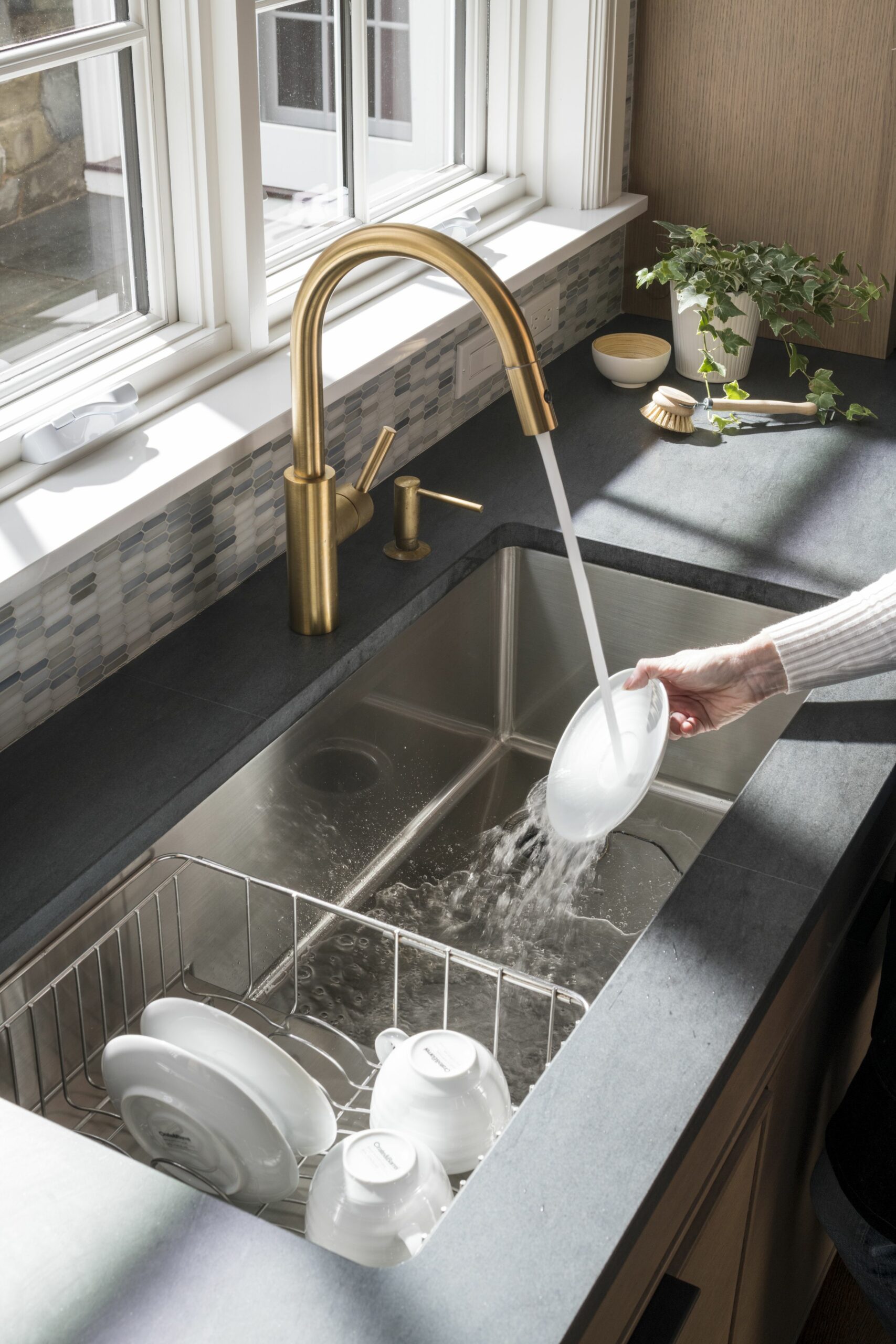
Source: Pinterest
What is the standard size of sink for kitchen?
Your kitchen’s typical sink has dimensions of 22 by 30 inches. Both a single bowl and a twin sink design can use this size. Due to the size of most cabinets and countertops, the front-to-back measurements frequently stay the same (i.e. 22 inches), although the width of various sink for kitchen types might vary greatly.
While double bowl versions of sink for kitchen may measure up to 48 inches in width, single bowl models can have wider width measurements of up to 33 inches. You may easily locate sinks for kitchen with a diameter of up to 60 inches if you choose triple bowl sinks!
What depth does a typical sink for kitchen have?
A typical sink for kitchen is between 8 and 10 inches deep. While the capacity to soak pans and pots more easily makes the deeper 10-inch sink appealing to some homeowners, shorter family members may not find these sinks for kitchen comfortable.
On the other hand, reaching and preparation work are made considerably easier with a shallow sink (8 inches deep). Prep sinks are typically put next to conventional sinks for washing dishes and cleaning products since they fall on the shallower end of the depth spectrum.
It’s important to bear in mind that undermount sinks sit approximately 2 inches lower than drop-in sinks when choosing the proper sink depth for you.
How do I choose the right size of sink for kitchen?
Prior to even considering additional kitchen amenities, you should concentrate on choosing the proper size. Furthermore, it’s crucial to keep in mind that the ideal size for a kitchen sink ultimately depends on the cabinet and kitchen space you have available, as well as the function you want your sink to fulfil.
Remember that a tiny kitchen may seem too big for even an average-sized sink. If your kitchen is small, less than 15,000 square feet or 10 by 15 feet, you should avoid buying giant units and instead go for smaller versions that fit under a regular sink.
You may easily choose the bigger sinks if your kitchen is larger, over 150 square feet. If you have a large family, you may even think about using double or triple-bowl designs.
Measuring the amount of cabinet space available
Always measure the area available where you intend to place the new sink before choosing any sink.
You only need to take specific dimensions and hunt for a sink that fits them if you intend to install your new sink in the current area.
However, if you’re replacing your kitchen sink, you’ll have the option to choose your sink size and the configuration of your cabinet space.
Kitchen cabinets typically range in height from 36 to 42 inches, in width from 25-1/4 to 26 inches, and in depth from 24 inches and more. This area can accommodate a normal 22 by 30-inch sink without any problems.
If your cabinet’s dimensions are bigger than this, a larger unit can easily fit in.
Measure the depth, height, and breadth of the cabinets in your kitchen, then deduct two to three inches from each dimension to determine the appropriate sink size.
Consider different sink for kitchen designs
When choosing the ideal sink size for your kitchen, it’s also important to take the installation style of a particular sink into account.
The following are the top three methods for installing kitchen sinks:
Sink for kitchen with a top mount

Source: Pinterest
The easiest type of sink to install is a top mount or drop-in sink. They don’t need to be set up by a professional because they are designed for installation from the top.
These sinks are simple to install on your own.
If you wish to switch to a larger model, you only need to make minor modifications to the new sink cutout hole to make room for a sink that is larger than the present one. It’s even simpler if you’re installing a new sink that is the same size as the old one. You may just take the new sink and place it inside the old hole without doing any renovation.
Top mount sinks have a visible rim that, if not hermetically sealed, may easily collect food detritus and grease, which is why some homeowners choose to avoid them. Additionally, this rim takes up counter space.
Under-mount sink for kitchen

Source: Pinterest
These sinks are made to install to the underside of your kitchen countertop and are secured using brackets, clips, or glue.
With this installation technique, the sink rim is fully concealed, making cleanup around the sink simpler and giving the room a more streamlined and modern aspect.
For granite, quartz, and stone worktops, these sinks work best.
Farm sink for kitchen or apron sink for kitchen

Source: Pinterest
The front edge of an apron sink extends over the edge of your countertop, thus the name.
They resembled vintage farmhouse sinks that were originally used as basins installed on kitchen tables or the tops of freestanding countertops and had a style that was popular in rustic kitchens.
Sizing these sinks might be a little challenging because of their unusual form, which causes them to protrude from the counter.
You’ll need to choose how much your sink should protrude from the wall, as opposed to other sinks.
The width of a typical kitchen countertop, which is 25 inches, makes location crucial when choosing the size of your farmhouse sink.
Avoid having a sink that jets out too much water or that takes up too much of the rear counter area. When determining the protrusion and location, your kitchen’s proportions should also be taken into consideration.
You should be prepared to receive an apron up to 10 inches long because the apron length is determined by the sink depth.
From 20 inches (excellent for a small kitchen) to 60 inches, you may get a farmhouse sink (ideal for larger families). Additionally, they are available in single, double, and triple bowl forms.
Sink for kitchen with mosaic tiles
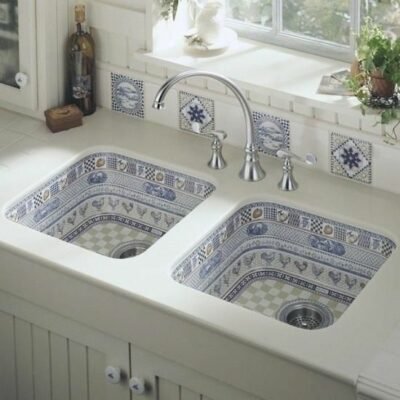
Source: Pinterest
Kitchen sinks with mosaic tiles up the glamour value of your kitchen. While, they look nice, they need good amount of maintenance like not keeping heavy pans in an irregular fashion that will result in the tile getting chipped.
See also about: kitchen sink design
Sink for kitchen made of copper
Kitchen sinks made of copper are in vogue. The pinkish brown colour gives the kitchen the much needed change from the use steel sink. If you have given an earthy theme to your kitchen, then a sink made of copper is the perfect choice for your kitchen.

Source: Pinterest
Space saving sink for kitchen
Your single bowl sink can double up as your workstation when not in use by simply lodging a bamboo cutting board or a board made of silicon. With this you get more counter space in your kitchen, making your cooking experience enjoyable.
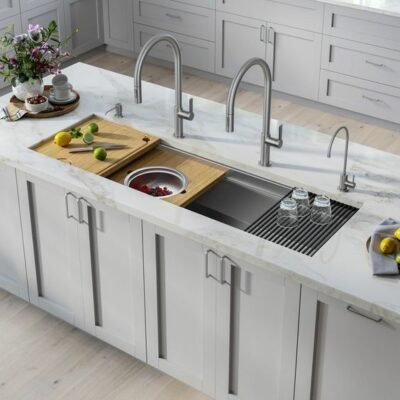
Source: Pinterest
Sink for kitchen in a different shape
Sink in a different shape can be the differentiator in your kitchen while also experimenting with the different colours and shapes. However, when you opt for such designs, do note that they should seamlessly blend with the kitchen and not make a wrong statement.
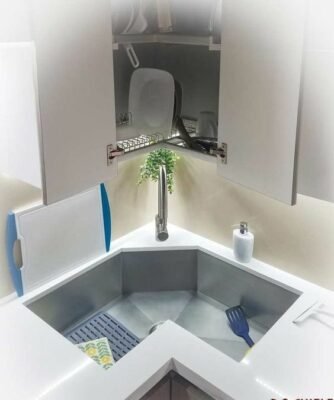
Source: Pinterest
Shallow sink for kitchen
Sinks need not always be deep. You can opt for a long shallow sink like the one shown above.
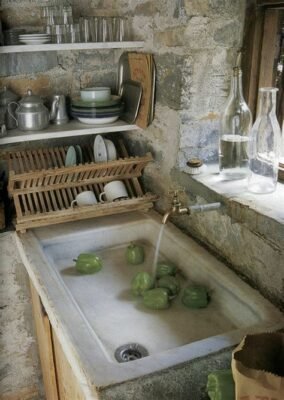
Source: Pinterest
What are common kitchen sink sizes?
| 22 inch |
| 24 inch |
| 30 inch |
| 33 inch |
| 36 inch |
| 45 inch |
How do I measure for a new kitchen sink?
Before installing a kitchen sink, start by measuring your counter space. Take measurements using a measuring tape. Note the length of the counter space where you want to install the sink. Consider the point from the back edge to the front edge of the counter, including any cabinets, drawers or appliances. Now, measure the width of the counter space starting from one side to the other.
What is the standard depth of a kitchen sink?
The standard depth of kitchen sink should be around 8 to 10 inch. A sink that is shallower may not have adeqaute space to soak pots and pans and wash dishes.
Can a larger sink be installed in an existing cabinet?
If you are planning to install a large sink within an existing cabinet, make sure the counter can accommodate the replacement size. You may have to remove the old countertop or cut out some portion, including the cabinet beneath it, before installing the new sink.
What is the average size of a double-bowl kitchen sink?
A double basin sink provides convenience and has become quite popular. Typically, a double-bowl sink has an average length of 30 to 33 inch. However, certain models may have a length of 40 or above.
FAQs
What size kitchen sink is typical?
The dimensions of a sink often rely on the inner width of the sink's cabinet, even though the typical kitchen sink is 22 by 30 inches (length by width). Cabinets typically have dimensions of 36 to 42 inches in height, 24 inches in depth, and 25-1/4 to 26 inches in width.
In a 36-inch cabinet, what size sink will fit?
In general, a sink of 33 inches works well with a 36-inch cabinet. However, a 36-inch sink is supposed to fit in a 36-inch cabinet when it is a farmhouse sink; therefore, there won't be any room on top.
What size double bowl sink is considered standard?
The normal dimensions of a double bowl sink are 33 inches in length, 22 inches in width, and 8 inches in depth, even though this sink is easily accessible in a variety of sizes for the convenience of homeowners. There are also often available sinks that are 36 inches long and have a 10-inch depth if necessary.
| Got any questions or point of view on our article? We would love to hear from you.
Write to our Editor-in-Chief Jhumur Ghosh at [email protected] |
Housing News Desk is the news desk of leading online real estate portal, Housing.com. Housing News Desk focuses on a variety of topics such as real estate laws, taxes, current news, property trends, home loans, rentals, décor, green homes, home improvement, etc. The main objective of the news desk, is to cover the real estate sector from the perspective of providing information that is useful to the end-user.
Facebook: https://www.facebook.com/housing.com/
Twitter: https://twitter.com/Housing
Email: [email protected]











